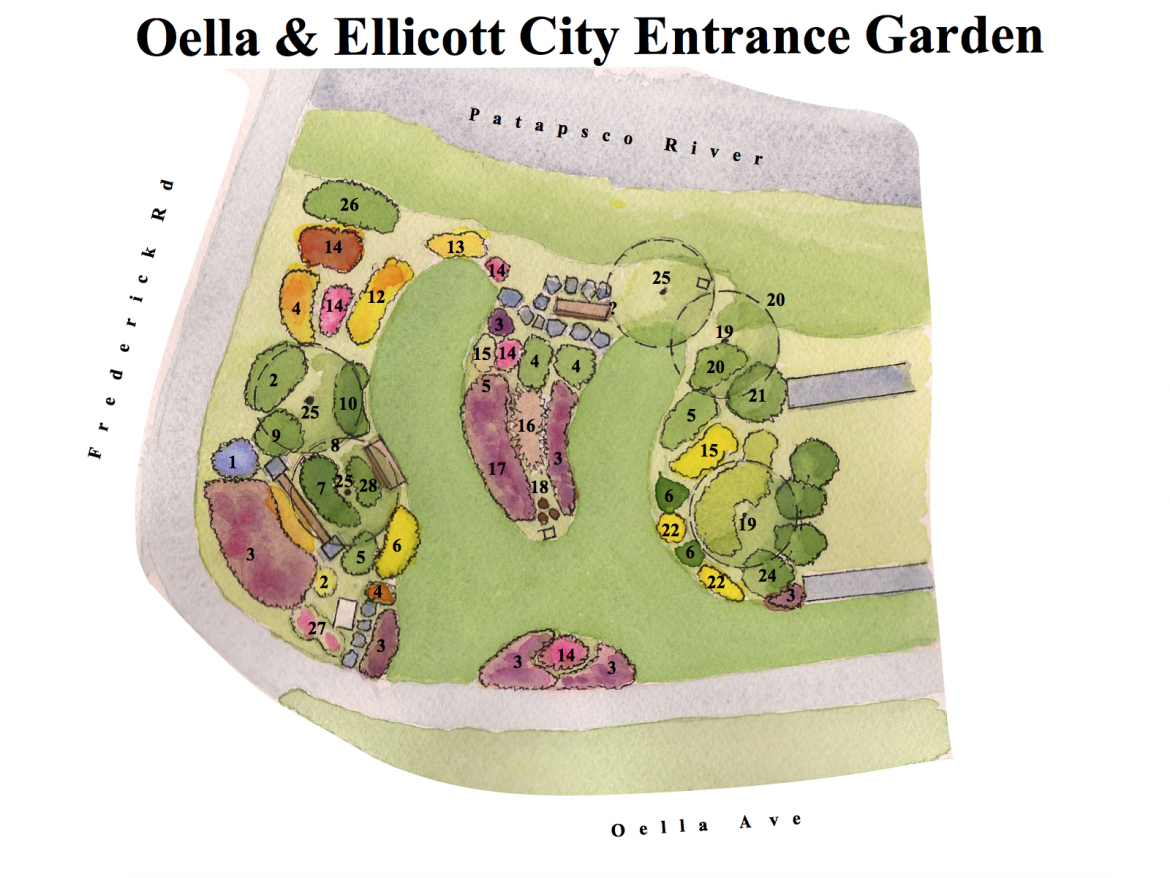
On a sunny, pleasant morning, after analyzing budget expenditures at the office, I walked through the Oella & Ellicott City Entrance Garden with Paul Farragut, Patapsco Heritage Greenway Board Member and the volunteer garden manager. He highlighted to me certain features of the garden that I will be detailing in this blog. At the bottom of the blog is a numbered key for the above watercolor depiction of the garden, drawn by Patapsco Heritage Greenway Past President, and landscape architect, John Slater.
When last year’s flood came surging down Main Street, the Patapsco River helped to flush all of the excess water. Unfortunately, on the banks of the Patapsco opposite Main Street sat a small native plant garden. The waters easily climbed the embankment and flooded the garden. Most of the plants were ripped from the soil, and any plants whose roots managed to cling to the Earth were covered in layers of silt and debris. Now, almost a year since the infamous flood that made national news, the Oella & Ellicott City Entrance Garden is in full summer bloom.
Where silt and debris covered what lonely plants held on along the banks of the river is now once again alive and thriving. After removing the silt and debris, native plants were reintroduced to the bare soil last fall, and more have been introduced this Spring, with funding from Patapsco Heritage Greenway and supported by the Chesapeake Bay Trust. Now, Goldenrod and Sumac cover the embankment above the Patapsco River. Goldenrod (solidago speciosa) has a high tolerance for silty soil, and Sumac (rhus) helps to keep the embankment from eroding.
The side of the garden close to the Frederick Road bridge has ditches dug between the garden and the grass to encourage excess water to flow towards the Patapsco River. This area of the garden, which was severely disturbed from the flood, is now home to Joe Pye Weed (eupatorium maculatum), a hardy perennial named after a Native American healer, Jopi, who used the plant to cure a variety of ailments, Purple Coneflower (echinacea purpurea), which American Goldfinches love as a food source, Black Eyed Susan (rudbeckia fulgida), the Maryland state flower, and Butterflyweed (asclepias tuberosa), also known as Milkweed. Because of the inclusion of Milkweed, the garden is certified as a Monarch Butterfly Waystation. The caterpillar of the monarch butterfly only eats plants of the Milkweed genus, meaning that the plant is crucial to the survival of the butterfly.
As we surveyed the progress of the garden in the pleasant summer sunlight, a lady seated on the shaded bench below a River Birch Tree spoke to us about how much she and her granddaughter enjoy the garden. The lady said that she visits the garden every day whenever she isn’t in Paris, but her granddaughter lives with her son in the area. The lady mentioned that the other day, the granddaughter was talking to her about how she’d like to thank whoever manages the garden, as she would like to volunteer to help maintain the garden. Luckily, we were there today! I wrote the name of our website on a piece of paper and told the grandmother that they could sign up through our website. If anyone reading this blog would also like to volunteer at the Oella & Ellicott City Entrance Garden, you can follow this link and write ‘garden’ or something similar in the box designated for ‘other’ volunteer opportunities, or simply email info@patapsco.org and let us know of your interest. I hope that everyone enjoys the garden, and I’m glad knowing that the community appreciates and supports its existence!
Key:
| BOTANICAL NAME | COMMON NAME |
| 1 – Symphyotrichum Novae-Angliae | New England Aster |
| 2 – Tradescantia Virginiana | Spiderwort |
| 3 – Nepeta x Fassennii | Catmint |
| 4 – Asclepias Tuberosa | Butterflyweed / Milkweed |
| 5 – Fothergilla Gardenii | Dwarf Fothergilla |
| 6 – Achillea x ‘Moonshine’ | Yellow Yarrow |
| 7 – Polygonatum Biflorum | True Solomon’s Seal |
| 8 – Lobelia Cardinalis | Red Cardinal Flower |
| 9 – Cornus Sericea | Red-twig Dogwood |
| 10 – Tiarella Cordifolia | Foam Flower |
| 11 – Hypericum Calycinum | St. Johnswort |
| 12 – Rudbeckia Fulgida ‘Goldstrum’ | Black Eyed Susan |
| 13 – Solidago Speciosa | Showy Goldenrod |
| 14 – Echinacea Purpurea | Purple Coneflower |
| 15 – Coreopsis Verticillata ‘Moonbeam’ | Moonbeam Coreopsis |
| 16 – Clethra Alnifolia | Sweet Pepperbush |
| 17 – Geranium Macrorrhizum ‘Bevan’s Variety’ | Cranes Bill Geranium |
| 18 – Pannicum Virgatum ‘Heavy Metal’ | ‘Heavy Metal’ Ornamental Grass |
| 19 – Cornus Florida Rubra | Pink Dogwood |
| 20 – Rhus | Sumac |
| 21 – Hamamelis Virginiana | Common Witchhazel |
| 22 – Liriope Muscari | Liriope |
| 23 – Phlox Divaricata | Woodland Phlox |
| 24 – Viburnum Dentatum | Arrowwood |
| 25 – Betula Nigra ‘Heritage’ | Heritage River Birch |
| 26 – Eupatorium Maculatum ‘Gateway’ | Gateway Joe Pye Weed |
| 27 – Lantana Camara | Lantana “Lucky Flame” |
